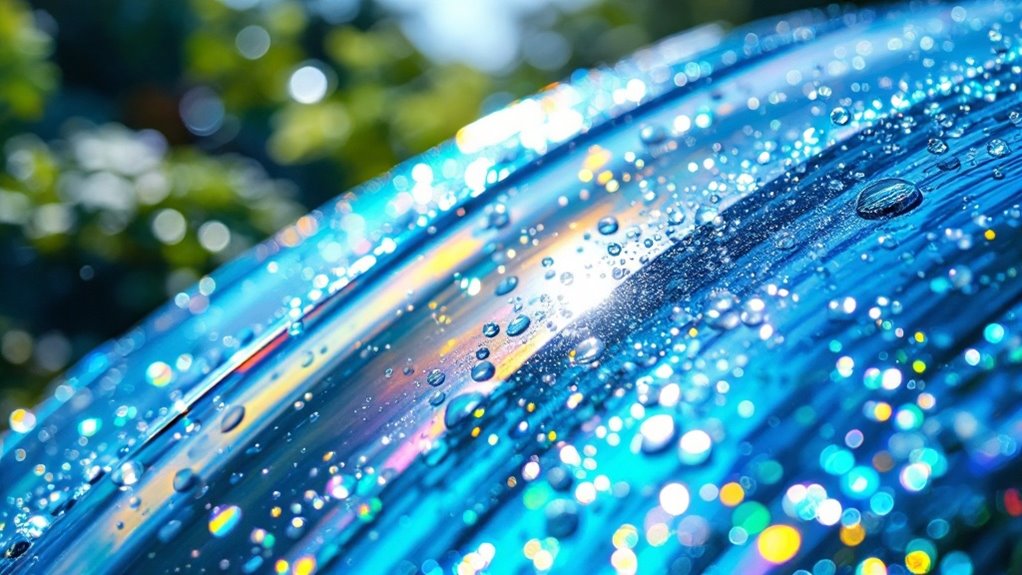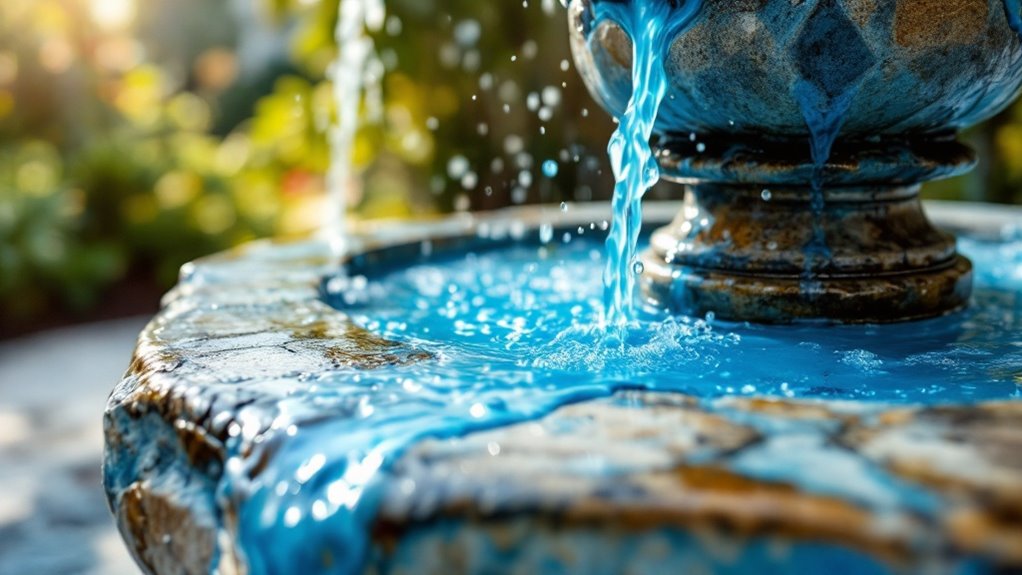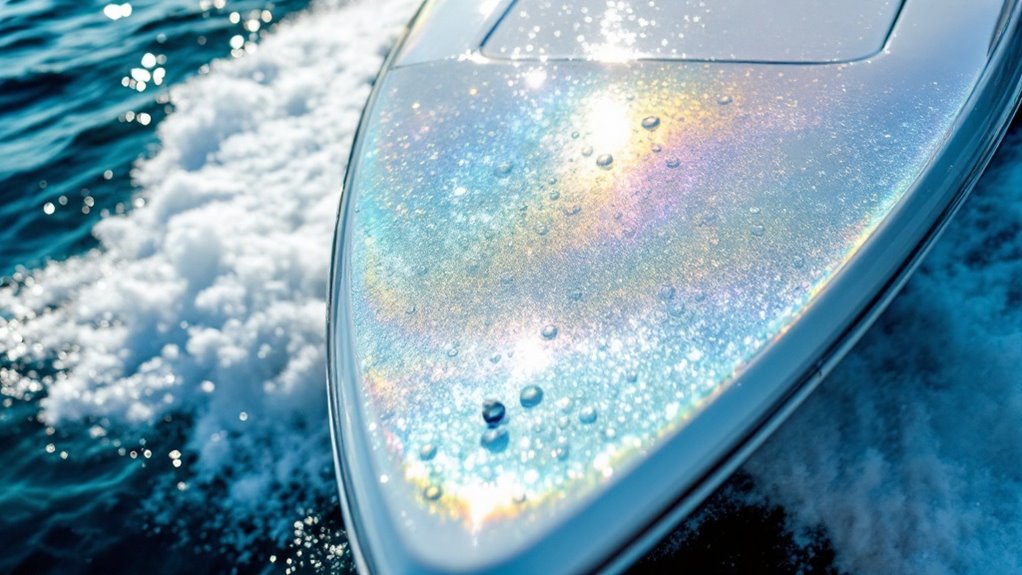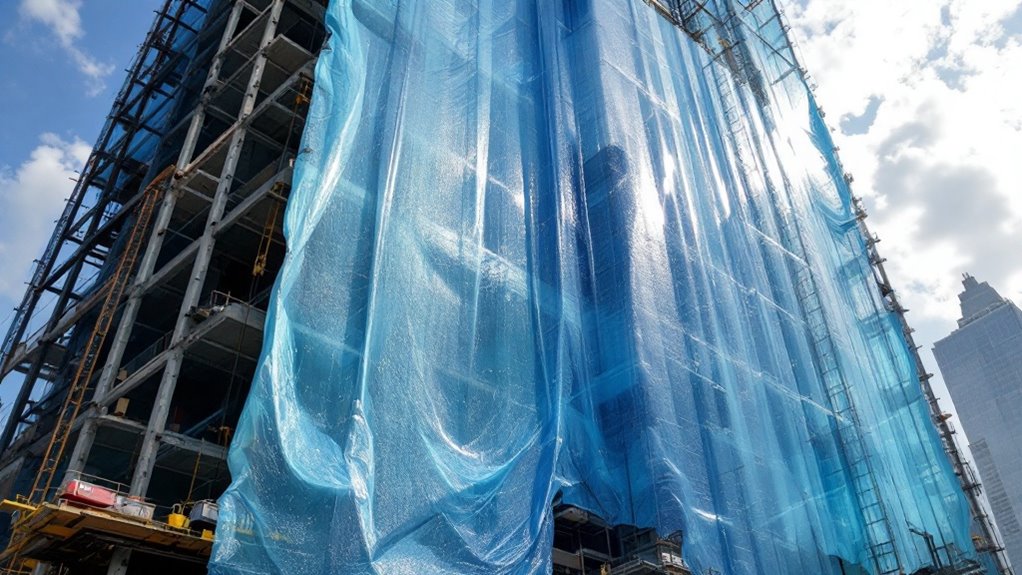We’re seeing liquid tarp technology transform surface protection across multiple sectors with eco-friendly innovations. These spray-on barriers, created from bio-based materials, offer superior protection while reducing environmental impact in agriculture, marine applications, and construction. From preserving industrial equipment to providing emergency shelter solutions, liquid tarps cut water usage by up to 30% and eliminate the need for harmful chemicals. Let’s explore how these sustainable solutions are revolutionizing traditional coverage methods.
Key Takeaways
- Liquid tarps create eco-friendly pest management barriers in agriculture, reducing chemical usage while protecting root zones and saving water.
- DIY waterproofing systems can be made by combining liquid tarp coatings with old bed sheets for custom outdoor furniture protection.
- Marine applications include advanced waterproof deck coatings and emergency repair solutions that prevent water ingress on vessels.
- Emergency response teams use liquid tarps for rapid shelter deployment with UV protection and fire-retardant properties.
- Construction sites benefit from dust containment systems and asset protection through liquid tarp applications integrated with security features.
The Science Behind Liquid Tarp Technology

While traditional tarps serve their purpose, liquid tarp technology represents a groundbreaking advancement in surface protection and erosion control.
We’ve developed these innovative solutions using primarily bio-based materials that work in harmony with the environment while delivering superior protection.
At the heart of liquid tarp innovations lies a sophisticated blend of natural compounds that create a protective barrier against wind and rain. The solution can be easily distributed using standard spray canons for efficient application across large areas.
We’re particularly excited about how these solutions minimize environmental impact through their unique composition. Unlike conventional covers, they’re specifically engineered for non-traffic surfaces where plastic alternatives prove impractical.
What’s more, our advanced formulations enhance stability and reduce maintenance requirements, making them a sustainable choice for various applications.
We’re seeing remarkable results in preventing material loss and protecting against environmental degradation across diverse settings.
Eco-Friendly Alternatives to Traditional Coverings
As sustainability drives innovation in the coverings industry, we’re proud to showcase an extensive range of eco-friendly alternatives that reduce environmental impact without sacrificing performance.
Our selection of eco-friendly textiles includes naturally renewable materials like bamboo, which offers exceptional anti-bacterial properties, and hemp, known for its durability and pest resistance. These materials provide less water usage during their production compared to traditional synthetic options.
We’ve also embraced innovative sustainable materials such as Piñatex, crafted from pineapple leaves, and seaweed-based coverings that align with vegan principles.
For industrial applications, we recommend our bio-based polyurethane coatings and water-based sealers that minimize VOC emissions while maintaining superior protection.
Agricultural Applications and Crop Protection

We’ve discovered that liquid tarps offer groundbreaking solutions for pest management through their spray-on application, creating an eco-friendly protective barrier that guards crops without harmful chemical residues.
These innovative formulations can be precisely targeted to protect root zones while maintaining ideal soil moisture levels, reducing water usage by up to 30% compared to traditional methods. The spray-on barriers also support weed suppression without the need for chemical herbicides, offering a natural alternative to conventional treatments.
Spray-On Pest Defense
Since sustainable agriculture demands innovative pest management solutions, our liquid tarp technologies have evolved to include sophisticated spray-on pest defense systems.
We’re combining advanced nanoparticle formulations with biodegradable coatings to create barriers that naturally repel pests while protecting your crops.
Our integrated approach to pest resistance management incorporates rotating organic pest solutions, including boric acid-based sprays and natural pheromone attracticides.
We’ve developed edible protective films that work alongside insect growth regulators, offering a thorough defense strategy that’s both effective and environmentally responsible.
The application targets problematic weeds like Sow Thistle and other invasive species that typically increase disease risks in agricultural settings.
Root Zone Moisture Control
Liquid tarp technology has revolutionized root zone moisture control through our innovative Hydretain formulation, which harnesses hygroscopic humectants to transform atmospheric moisture vapor into plant-available water droplets.
We’re proud to offer this sustainable solution that reduces irrigation needs by up to 50% while maximizing moisture retention in your soil.
This advanced formula must be applied when soil moisture is present, ensuring optimal effectiveness and lasting results.
Our eco-conscious approach to irrigation optimization supports both food-producing agriculture and ornamental crops.
We’ve engineered Hydretain to work seamlessly with existing fertilizer programs, enhancing nutrient uptake efficiency through improved soil moisture management.
Available in liquid and granular forms, our solution provides flexible application options for your specific needs.
Together, we’re preserving water resources while improving crop yields through advanced moisture management that stays effective for up to three months.
Industrial Solutions for Equipment Preservation
When protecting valuable industrial equipment from environmental damage, our innovative preservation solutions offer sustainable and scientifically-proven methods that reduce waste while maximizing asset longevity.
We’ve developed specialized tarp systems incorporating vapor moisture impervious materials and advanced desiccant technology to guarantee peak equipment preservation in any environment.
Our commitment to equipment longevity extends beyond basic coverage – we’re implementing anti-static and fire-retardant materials that protect sensitive machinery while meeting strict safety standards.
By utilizing reinforced perimeters and precision sealing technologies, we’re creating microenvironments that effectively control humidity and prevent corrosion. Our specialized forced hot air sealing process ensures complete protection against moisture infiltration.
Together, we’re revolutionizing asset preservation through sustainable practices, offering customizable solutions that adapt to your specific industrial needs while reducing environmental impact and extending the life of your valuable equipment.
DIY Home Projects With Liquid Tarp Coatings

While protecting industrial equipment requires specialized solutions, homeowners can create their own sustainable waterproofing systems using innovative liquid tarp coatings.
Through creative upcycling, we can transform old bed sheets into durable waterproof covers using a simple 5:1 ratio of solvent to silicone, achieving professional-grade results at a fraction of the cost.
We’ve found that fabric restoration through this method opens up numerous possibilities for sustainable home projects.
Let’s create custom outdoor furniture covers, pool covers, and garden awnings that last longer than conventional options.
Waterproofing Solutions for Outdoor Gear
Three major shifts in outdoor gear waterproofing have revolutionized how we protect our equipment.
First, we’ve seen a dramatic move toward eco-friendly innovations, with companies like Nikwax and Granger’s leading the charge in PFAS-free, non-toxic solutions. Technology has advanced to where water beads up naturally on treated fabrics.
Second, sustainable practices have emerged through natural alternatives like wax-based treatments and plant-derived oils, which we’re increasingly using for canvas and leather gear.
Finally, we’re embracing water-resistant treatments that combine performance with environmental responsibility.
When we maintain our outdoor gear with these new solutions, we’re not just protecting our equipment – we’re protecting our planet.
Marine and Boating Applications

We’ll explore how liquid tarps revolutionize marine protection through advanced waterproof deck coatings that shield against harsh maritime elements while reducing environmental impact.
Our sustainable solutions streamline hull maintenance by creating protective barriers that minimize the need for harsh cleaning chemicals and extend vessel lifespans. These protective measures ensure vessel preservation and durability through high-quality PVC-based formulations.
When emergency repairs become necessary at sea, these innovative liquid applications provide quick-sealing, durable patches that help prevent water ingress until permanent fixes can be made.
Waterproof Deck Protection Solutions
Since protecting marine decks requires specialized solutions that withstand harsh saltwater conditions, we’ve developed innovative liquid tarp applications that offer superior waterproofing performance.
Our deck moisture management system combines polyurethane coatings with liquid membranes that stretch up to 300% without tearing, perfect for surfaces prone to movement and temperature fluctuations.
When it comes to sealant application techniques, we recommend a multi-layer approach.
First, thoroughly clean and prepare the surface, then apply thin, even coats of our eco-friendly liquid membrane. The coating provides excellent coverage of 100-150 square feet per gallon on porous surfaces. This creates a seamless barrier that prevents water intrusion while maintaining deck aesthetics.
We’ve incorporated UV-stable compounds and anti-fracture properties into our formulations, ensuring your deck stays protected season after season while minimizing environmental impact.
Hull Maintenance Made Easy
Maintaining your boat’s hull requires an integrated approach that balances effective cleaning with environmental stewardship.
At our marinas, we’ve found that successful hull cleaning starts with choosing the right products and methods while protecting our waterways.
We recommend using phosphate-free and VOC-free cleaners like ZING Marine Safe for your hull cleaning routine. For tough stains and mineral deposits, use a non-abrasive acid cleaner that won’t damage fiberglass surfaces.
When working on your vessel, always use containment tarps and filter cloth to prevent debris from entering the water.
For lasting surface protection, apply multiple layers of carnauba wax to maintain your gel-coat’s integrity.
Emergency Marine Repairs
When disaster strikes on the water, having reliable emergency marine repair solutions can mean the difference between a minor setback and a catastrophic incident.
We’ve seen remarkable advances in emergency repair techniques, from the DNV GL-qualified Magnetic Miko Plaster for sealing hull breaches to the innovative ClamSeal Repair Clamp for inflatable repairs. These specialized patches are particularly effective as they create a secure seal through magnetic adhesion and pressure.
For ideal marine equipment longevity, we recommend keeping thorough repair kits like WEICON’s emergency solutions on board.
These eco-conscious systems include sustainable vinyl patches, marine epoxy, and waterproof sealants that effectively address various marine emergencies.
Our community of boat owners particularly values the versatility of these solutions, which can handle everything from torn vinyl seats to compromised hull integrity – all while minimizing environmental impact through reusable components and environmentally-responsible materials.
Construction Site Protection Methods

As modern construction sites face increasing security and environmental challenges, extensive protection methods have become essential for safeguarding assets while minimizing ecological impact.
We’ve discovered that liquid tarps offer innovative solutions for construction safety and site durability, complementing traditional security measures like perimeter fencing and surveillance systems.
When we implement these advanced protection methods, we’re not just securing equipment and materials – we’re creating a safer environment for everyone. Motion-activated lights installed strategically around the perimeter provide enhanced visibility and deter potential intruders.
By integrating dust containment systems and reusable protective products, we’re reducing our environmental footprint while maintaining stringent safety standards.
Let’s remember that effective site protection isn’t just about physical barriers; it’s about creating a comprehensive system that addresses security, sustainability, and community safety through smart, eco-conscious choices in materials and methods.
Seasonal Storage and Weather Protection
Three key factors make liquid tarps essential for seasonal storage and weather protection: their adaptability to changing conditions, minimal environmental impact, and superior protection against harsh elements.
We’ve found that their seasonal effectiveness extends beyond basic coverage – our liquid tarps actively manage temperature fluctuations while preventing moisture buildup. Similar to propylene glycol solutions, these covers provide environmentally responsible protection.
Their weather adaptability truly shines in diverse applications. Whether you’re storing sensitive equipment or protecting vehicles, these innovative covers provide a sustainable solution that meets environmental compliance standards.
They’re particularly effective for spill containment and chemical protection, featuring breathable materials that prevent condensation while maintaining waterproof barriers.
Join us in embracing eco-conscious storage solutions. Our reinforced polyethylene and anti-static options offer UV resistance and durability, ensuring your valuable assets remain protected throughout seasonal shifts.
Emergency Response and Disaster Preparedness

We’ve discovered that liquid tarps play an essential role in emergency response by enabling rapid shelter formation within minutes of a disaster striking.
Our innovative formulations create protective barriers that shield critical emergency equipment and supplies from harsh environmental conditions while maintaining accessibility.
These eco-conscious solutions are particularly effective for temporary deployment scenarios, as they can be quickly applied and later removed without leaving harmful residues in disaster-affected areas. The color-coded system allows emergency responders to efficiently manage disaster zones by clearly marking hot, warm, and cold areas for optimal safety and response coordination.
Rapid Shelter Formation
When disaster strikes, liquid tarps provide an invaluable rapid-response solution for emergency shelter formation.
We’ve found that versatile shelter design options, including A-frame and lean-to configurations, offer significant protection while maintaining minimal environmental impact. Setting up shelter should be a first priority to preserve both physical and mental energy in emergency situations.
Our community’s experience shows that these adaptable tarp configurations excel in various emergency scenarios.
Using sustainable materials like silnylon and eco-friendly polymers, we can quickly establish protective spaces that serve multiple individuals. The key lies in strategic setup using natural anchor points like trees and rocks, combined with proper tensioning techniques.
We’re particularly drawn to the diamond and C-fly setups for their efficiency in materials use and superior weather protection.
These designs demonstrate how we can maximize protection while minimizing our environmental footprint during emergency situations.
Emergency Equipment Protection
Beyond sheltering people, liquid tarps excel at protecting essential emergency equipment during disaster response operations.
We’ve found these innovative protective equipment strategies particularly effective when safeguarding sensitive electronic devices and vital machinery from multiple environmental threats.
Our emergency tarp applications now incorporate advanced features like anti-static properties to prevent electrical damage, while simultaneously offering UV and water protection. The heavy-duty silver tarps with double-laminated coating provide exceptional durability for protecting critical equipment.
We’re especially proud of our mold-resistant formulations that guarantee equipment stays operational in humid disaster zones.
The thermal-insulating properties help maintain ideal equipment temperatures, while fire-retardant characteristics provide an extra layer of safety.
Frequently Asked Questions
Can Liquid Tarps Be Applied Over Existing Traditional Tarp Surfaces?
We don’t recommend applying liquid tarps over existing ones due to potential compatibility issues. However, with proper surface preparation, it’s possible on some materials – though we suggest consulting specific manufacturer guidelines.
How Long Does It Take for a Liquid Tarp Coating to Dry?
We typically find that liquid tarp drying time ranges from 4-8 hours between coats, depending on coating thickness. For full curing, we recommend waiting 24-48 hours under ideal conditions.
Are Liquid Tarps Safe to Use Around Pets and Children?
We’re confident in liquid tarps’ pet safety and child safety profiles, as they contain non-toxic ingredients at minimal concentrations. When used as directed, they pose negligible risks compared to common household chemicals.
What Temperatures Can Liquid Tarp Applications Withstand Before Breaking Down?
We’ve found liquid tarp coatings typically maintain their temperature resistance between 180-200°F, though breakdown thresholds can vary. For maximum durability, we recommend staying within these sustainable operating limits.
Can Liquid Tarps Be Removed or Stripped if Needed?
We can remove liquid tarps through specialized removal processes, using eco-friendly solvents and pressure washing. While application challenges vary by surface type, proper techniques guarantee complete stripping without environmental harm.
Conclusion
We’ve witnessed liquid tarp technology transform from a niche solution into a versatile protective innovation that’s reshaping multiple industries. As we continue exploring sustainable alternatives to traditional coverings, we’re committed to advancing these eco-conscious solutions. By embracing liquid tarp applications, we’re reducing material waste while providing superior protection across diverse environments. The future of protective barriers lies in these adaptable, environmentally responsible technologies.
